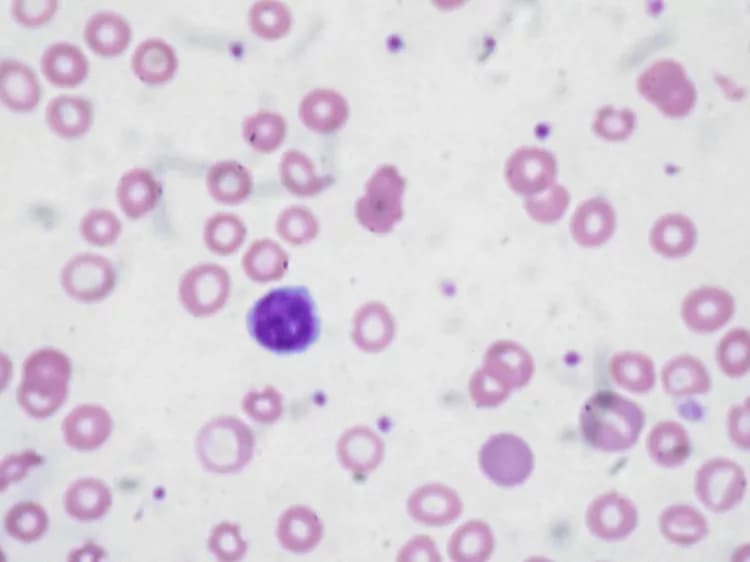What are the other Names for this Test? (Equivalent Terms)
- Blood Smear Test
- Erythrocyte Morphology
- Red Blood Cell Morphology
What is Peripheral Blood Smear Examination? (Background Information)
- A Peripheral Blood Smear Examination is a procedure, which involves spreading a drop of blood thinly onto a glass slide. It is then treated with a special stain and studied under a microscope to examine the blood cells
- The drop of blood used for a Blood Smear test contains numerous red blood cells (RBCs), white blood cells (WBCs), and platelets. The red blood cells (RBCs) help carry oxygen via blood, to different parts of the body. The function of white blood cells (WBCs) is to fight infection. Platelets are vital for the formation of blood clots during any injury, to prevent bleeding
- A Blood Smear test gives information on the number, shape, and general appearance of the blood cells
- It also helps diagnose a range of deficiencies, diseases, and disorders involving blood cell production, function, and destruction
- The test is also occasionally used to look for parasites causing malaria and filaria, within blood
What are the Clinical Indications for performing the Peripheral Blood Smear Examination?
Clinical indications for performing a Peripheral Blood Smear Examination include:
- Your healthcare provider may perform this test as part of a general health exam, to help diagnose many illnesses
- This test is also used to monitor or evaluate the effectiveness of treatment, once a diagnosis is made and the treatment started
- Many a time, the Blood Smear test is ordered as a more definitive evaluation tool after a complete blood count (CBC) with automated differential test has been performed, and a blood disorder/deficiency suspected
Some conditions for which the test may be performed include:
- Anemia
- Cancers or leukemia (hairy cell leukemia)
- Myeloproliferative disorder
- Hemoglobinopathies; a group of genetic disorders affecting hemoglobin present in the RBCs. E.g. sickle cell anemia and thalassemia
- Bone marrow disorder
- Bleeding disorders
- Thrombocytopenia (decreased platelets)
- Allergies
- To monitor the side effects of chemotherapy
- Parasitic infections (like malaria or filaria), other infections, inflammations
Some of the signs and symptoms associated with blood cell disorder or deficiency includes:
- Weakness or fatigue, lack of energy
- Paleness
- Easy bruising or excessive bleeding
- Fever
- Bone and joint pain
- Frequent infection
- Enlarged spleen
- Yellowing of skin or white of the eye
- Blood in urine
How is the Specimen Collected for Peripheral Blood Smear Examination?
Sample required: Blood
Process:
- Adult: Insertion of a needle into a vein (arm), or by pricking a finger or ear
- Infant: Pricking a heel
Preparation required: None
What is the Significance of the Peripheral Blood Smear Examination Result?
- The results of the Peripheral Blood Smear Examination do not confirm a disease or a condition
- The test results are evaluated by the physician along with the other clinical signs and symptoms
- Test results from other investigations are often used to form a diagnosis
- The appearance of the blood cells, as well as other findings as seen under the microscope, will help the healthcare provider move in the right direction towards finding the cause of the problem, its severity, and if there is a need for further analysis/exam
- All these factors would aid in providing a suitable treatment to the individual
The laboratory test results are NOT to be interpreted as results of a "stand-alone" test. The test results have to be interpreted after correlating with suitable clinical findings and additional supplemental tests/information. Your healthcare providers will explain the meaning of your tests results, based on the overall clinical scenario.
Additional and Relevant Useful Information:
- A drop of blood contains millions of red blood cells (RBCs). Mature RBCs are round, biconcave and do not have a nucleus. RBCs appear red-pink in color with a pale center. It contains a chemical called hemoglobin, which gives blood its characteristic red color. The size of the RBC is about 7 micrometers, and is uniform throughout
- A drop of blood contains thousands of white blood cells (WBCs). There are five different types of WBCs. These are neutrophils, eosinophils, basophils, lymphocytes, and monocytes. During the examination of Blood Smear, approximately 100 WBCs are counted and the percentage of each WBC types are calculated and reported in the results
- A drop of blood contains about hundreds to thousands of platelets. Platelets are usually seen as cell fragments and are observed for their change in size or shape, during the examination of a Blood Smear
Certain medications that you may be currently taking may influence the outcome of the test. Hence, it is important to inform your healthcare provider, the complete list of medications (including any herbal supplements) you are currently taking. This will help the healthcare provider interpret your test results more accurately and avoid unnecessary chances of a misdiagnosis.
Related Articles
Test Your Knowledge
Asked by users
Related Centers
Related Specialties
Related Physicians
Related Procedures
Related Resources
Join DoveHubs
and connect with fellow professionals


0 Comments
Please log in to post a comment.